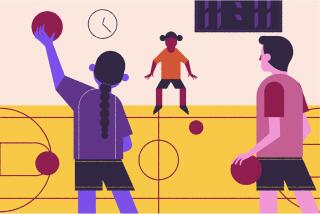Puck ‘er Up! : Trends: With Wayne Gretzky, came hockey. Now the fever has begun to trickle down to players in the street.
- Share via
A boy roller-skates through a schoolyard with his hockey stick in hand, rushing at an imaginary goalie, cocking for a 100-m.p.h. slap shot just like the big guys do. He could be any kid in Vancouver or Toronto or New York, where street hockey ranks with sandlot baseball. But this boy is in Southern California, and the game seems as foreign as glacial ice.
In Cypress, players compete on a concrete slab beneath the City Council chambers--waiting for the “no hockey” signs to be posted.
In Garden Grove, they play on an improvised concrete and plywood rink in a public park, where next month the city’s first roller hockey class begins. The city plans to open a full-fledged roller hockey rink within a year.
At a Torrance park near the beach, sunbathers and softball players stop to watch an oddity on the plaza. A dozen men skate after a puck, their polyurethane wheels shrieking against concrete. The neighborhood guys are gathered for their new favorite sport.
“A few years ago, we couldn’t get enough people to have a game,” said Patrick Hebert, a 27-year-old grocery clerk and goalie. He’s a regular at Charles Wilson Community Park. “Now we have too many people.”
Latecomers wait on the sidelines.
“Everybody wants to be Wayne Gretzky,” said Manny Pedroza, twirling his stick in the shade.
Hockey has taken hold in this semi-arid land, and it has grown in upside-down fashion. Few people cared about it until 1988 when a wealthy businessman paid its brightest star, Gretzky, millions of dollars to play at the Forum. Suddenly, Dustin Hoffman and Sylvester Stallone wanted rink-side seats. This season, the Kings sold out more games than the Lakers.
Then, the L.A. Kings Slap Shop, selling hockey souvenirs and paraphernalia, opened in Santa Ana. The Kings discovered Orange County to be a hotbed of hockey enthusiasm; 25% of their fans come from here, mostly from the Costa Mesa-Newport Beach area.
But only now is the sport trickling down to its grass roots. Thousands of young men and a few young women are lacing on roller-skates, playing on any open stretch of pavement, which is the nearest thing to a frozen pond in Southern California.
“It caught us by surprise,” said Cal Rietzel, who has charge of Garden Grove’s recreation department. “Maybe a year ago we started seeing it. Now almost every city I go through, I see kids on cul-de-sacs and basketball courts and tennis courts playing pick-up games.”
Garden Grove has reacted by allocating money for a roller hockey area, probably opening within a year in Garden Grove Park.
With summer, the street game is heating up. In addition to pick-up sessions, there are weekly hockey nights at roller rinks. A dozen new leagues have popped up, accounting for about 2,000 skaters. Even Gretzky has noticed.
“The kids have really caught on,” he said. “Obviously we have a minor problem here with a little bit of a shortage of ice . . . but everywhere I go I see kids playing.”
Street, or roller, hockey is much like its frozen counterpart. Six-person teams play on a rectangular rink. There is a goal and goalie at either end.
The street hockey puck is made of lightweight plastic. Some players wear conventional roller-skates. A good number wear Rollerblades, a high-tech skate designed in 1980 by two Minnesota brothers who wanted to practice hockey during the summer. Because the four wheels are set in a line, Rollerblades look like hockey skates.
Last year the company almost tripled its Southern California sales to 55,000 pairs and estimated that more than 5,000 of those pairs were bought by hockey players. Other brands, including one endorsed by Gretzky, have copied the style.
Sales are “definitely huge,” said Jason Park, assistant manager of the Kings Slap Shop in Santa Ana. The skates, costing $80 to $300, “sell really big. Parents will come in and buy both their kids skates and sticks and pads. We’ve had weekends where we sold 50 or 60 sticks.”
Skating is the principal component in street games, which tend to have few rules, no penalties and constant movement. Players don’t have to be big, just fast.
“Not every kid is a basketball or football player,” Pedroza said. “If you can skate, you can be as good as someone who’s 10 feet tall.”
Most local players are new to the sport, so even beginners can get into games at places such as Torrance’s Wilson Park. On a recent Sunday several dozen regulars showed up throughout the day. The score was of nominal concern as some players peeled off their shirts to get a tan. Equal amounts of hard skating and laughter punctuated the afternoon.
George Giourof was tending goal for one team, sweating beneath thick pads that covered him from head to toe. He grew up in Montreal and said there isn’t much comparison between players in the two cities.
“Day and night,” Giourof said. “In Canada there are 10-year-old kids who would blow these guys away.”
But nobody seemed to care.
“We’re out here to have fun,” said David Nguyen, a quick skater who stood out from the crowd in his orange jersey.
Such a relaxed atmosphere is due, in part, to the fact that street hockey is less violent than ice hockey. Checking--body-slamming and elbowing--is forbidden. But with skaters moving fast in tight quarters, contact is inevitable. And in some games, contact is more inevitable than in others.
The action can get downright chippy, as hockey players say, at the Skate-O-Rama rink in Downey. League playoffs started on a recent Saturday and, in a morning game, one team quickly fell behind. Angry words and shoves ensued.
“People get frustrated,” said Lonnie Stokes, a 26-year-old construction worker who was waiting for his team to play in a later game. “Last week we had a bench-clearing brawl.”
Stokes is a street-hockey nomad, venturing from his Valencia home to Downey or Sherman Oaks or anywhere else he can find a game. “I gave up a girlfriend to play,” he said. On weekends, in indoor leagues, he enjoys the luxury of referees and uniforms. Three nights a week he finds ragtag games.
Either way, he likes his play as rough as the NHL. His body is a catalogue of treasured and painful hockey memories.
“I’ve broken every finger at least twice,” Stokes said. “I’ve had surgery on my knee, and had my cheek cut by a stick.
“But in roller hockey, we keep our teeth.” He smiled to prove it.
Most players suffer only bumps and bruises. “We get scraped knees from falling,” Nguyen said. The threat of serious injury, however, makes street hockey a scourge among school principals and park directors.
Informal games often get rousted. Players are forced to move to another spot. A group of San Fernando Valley men avoid the authorities by playing late at night in a lighted parking lot. In Agoura a group pitched in for insurance so they could use the high school grounds.
In Cypress, nearly round-the- clock pick-up hockey was being played on a concrete slab beneath the City Council chambers. But the City Council, told of noise and damage to city property, banned hockey there last week. The council promised to provide an alternate site, although a previous effort to find one failed.
Street hockey has even been hit by blasts aimed elsewhere. Ordinances passed in Dana Point, Laguna Niguel and Huntington Beach to control reckless or malicious skateboarding also affect roller skaters.
In those cities, businesses may apply to City Hall and have their sidewalks and parking lots posted, thereby prohibiting all kinds of skating. In Laguna Niguel, skating is illegal in the street, so one complaint can shut down any street hockey game.
Newport Beach also is considering such an ordinance.
Some people figure all the fuss will die down once Gretzky retires. Hockey’s popularity will ebb, they say. But the Great One argues that today’s street-hockey youth are tomorrow’s lifelong fans.
“Those kids will grow up and want to go to games and take their kids to games,” he said.
A new NHL team, the San Jose Sharks, is thinking along similar lines. The club is sponsoring a “Sharks and Parks” street hockey league at community centers throughout the San Francisco Bay Area. Team officials said they’re hoping to get kids hooked on the game at an early age.
Twenty years ago, soccer was being hailed as the U.S. sport of the future. That movement was institutionalized in a national, adult-run league. There’s a difference with street hockey: The kids have started playing it on their own.
For some of those youngsters, hockey is a replacement for traditional sports they either disliked or weren’t good at.
“I played baseball,” said Bryan Miller, 11, of Agoura. “I played left field and never got any balls.”
Miller now plays street hockey in an Agoura youth league that has tripled in size to 350 players this season. He and his teammates arrived for practice on a recent Thursday afternoon and spent the first 10 minutes strapping on knee and elbow pads, shin guards and gloves, helmets and hip protectors.
“It’s kind of expensive,” said Mary Johnston, who has three sons in the league. “We spent $1,000 on equipment.”
That’s still less costly than ice hockey, which requires even more equipment. Renting a rink can cost up to $225 an hour. And with relatively few rinks in Southern California, some teams can’t get practice time until late at night.
At the Agoura league practice, on a pleasant afternoon amid unseasonally green hills, mothers and fathers sat in lawn chairs and chatted as their children skated through drills on a junior high school volleyball court.
“Chad didn’t like baseball. He didn’t like soccer. He was bored to death,” said Maggie Orzechowski of her 10-year-old son who has taken to skating laps around their back-yard pool.
“He practices,” Orzechowski said. “He’s never practiced anything in his life.”
Similar leagues have started up at the East Bluff Boys and Girls Club in Newport Beach and at the Weingart-Lakewood YMCA in Long Beach, where the director is having a rink built in back because he figures street hockey is a natural for young people.
“Kids love to roller-skate,” said Joe Twyman. “Now we’re giving them a game along with it.”
As for adult players, some are transplanted Easterners who grew up on the game. Others were converted by watching the Kings on television. Some have particularly Californian reasons to play.
“A lot of people started by skating at the beach,” Hebert said. “It’s a good way to stay in shape.”
Lonnie Stokes might not think much of this healthy logic. But he is glad to have enough people to play with.
“It’s pretty freaky that hockey’s getting so big here,” he said. “You can play it almost anywhere now. Of course, I’ll drive two hours just to play for 55 minutes, then I’ll drive back. I really will.”
More to Read
Go beyond the scoreboard
Get the latest on L.A.'s teams in the daily Sports Report newsletter.
You may occasionally receive promotional content from the Los Angeles Times.







